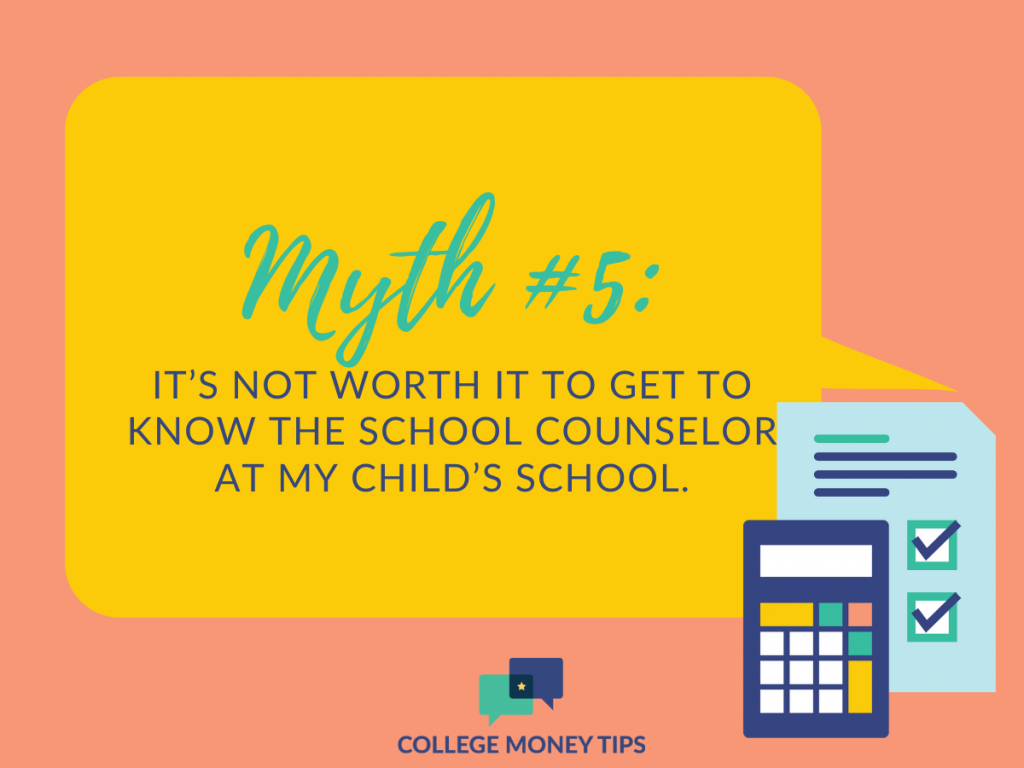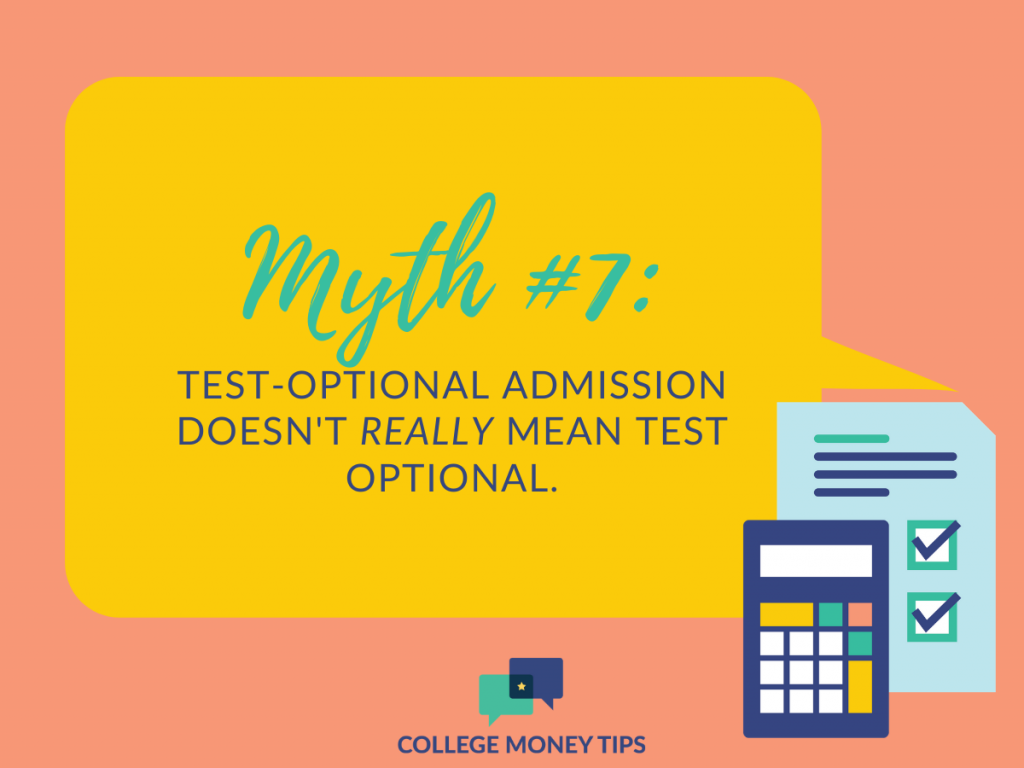Now that it’s back-to-school time, your child (or you!) may be in paralysis mode. Are you ready to launch the college search?
It’s okay to say no.
I know that it’s easy to feel completely unprepared, especially when the college search is changing so much right now.
I thought of five myths right before breakfast. I’m channeling the show “MythBusters” because my 12 years in college admission means I’ve seen it all.
Here are eight quick myths about college admissions, the college search and saving for college that I’m attempting to bust forever.
Contents
- Myth #1: I shouldn’t save for college right now because of market volatility.
- Myth #2: It’s too late to save for college if my child’s in high school.
- Myth #3: “Shoulda, woulda, coulda” is helpful in the grand scheme of things.
- Myth #4: It’s a good idea to write a laser-focused COVID-19 college admission essay.
- Myth #5: It’s not worth it to get to know the school counselor at my child’s school.
- Myth #6: We’ll pay the sticker price at colleges.
- Myth #7: Test-optional admission doesn’t really mean test optional.
- Myth #8: I’m in charge of my kid’s college search.
- Busted!
Myth #1: I shouldn’t save for college right now because of market volatility.
Market volatility can actually benefit you right now. The downturn in the markets means that you’ll be getting your investments “on sale.” Let’s say you just had a newborn. A portfolio diversified with a mix of stocks and bonds means you can buy shares of his 529 plan with less money.
Here’s what happens when the market goes up: You’ll still have that exact number of shares when the market goes back up — and they’ll be worth a lot more money.
It’s a really, really good idea to save for college right now.
Myth #2: It’s too late to save for college if my child’s in high school.
Let’s say your child is a high school junior and you’re thinking it’s too late to save for college.
You should save. There’s a really good reason for that, too. A study showed that it’s more likely that your child will go to college, even if you don’t have a lot saved. The study said that if parents save a small amount (less than $500), a child is 25 percent more likely to enroll in college and 64 percent more likely to graduate than a child with no savings. The study is from the Center for Social Development at Washington University in St. Louis.
In a nutshell, the study says that a low-to-moderate income child with school savings of $1 to $499 before college age is more than three times more likely to enroll in college than a low-to-moderate income child with no savings account and more than four and half times more likely to graduate. In addition, a low-to-moderate income child with school savings of $500 or more is about five times more likely to graduate from college than a child with no savings account.
Myth #3: “Shoulda, woulda, coulda” is helpful in the grand scheme of things.
I looked back on something I wrote in 2017: My daughter turns *gasp* four years old this week. Gone are the days of that sweet little voice chirping, “ma-ma.” Now, she’s deftly picking out “cat,” “in,” and “hat” while we read. (Yes, we did read “The Cat in the Hat” for a bedtime story tonight.)
I work in undergraduate admission at my alma mater, Central College, and just for a bit of fun (with a heart attack on the side), I decided to check out College Board’s college cost prediction for her in 14 years. (A really short amount of time, mamas!)
If she makes the same college choice I did, it’ll cost $137,125 (sticker price) for her freshman year alone.
Cue jaw drop.
BUT! The admission professional in me says—nobody pays full sticker price. TRUE! Plus, there are scholarships, grants, loans, etc. YES! Plus… parental savings. Right.
Believe it or not, it’s possible to save for college. There are more savings options than ever, from prepaid tuition plans to tax-deferred accounts to 529 plans.
Also… this. One of the coolest things I use (and won’t shut up about) is www.upromise.com. Upromise Rewards is a free loyalty program, in which you can earn cash back for college on “what you already do and buy,” which is exactly what the website touts. You can shop online, go out to eat, buy groceries, book a vacation, and earn cash back for doing it.
Example: We have plans for a family wedding in Mexico this November. My credit card’s r
This works for grocery stores using grocery coupons, at popular websites such as Gap, Ann Taylor, Kohl’s, Neiman Marcus, J.Crew, The Children’s Place, diapers.com — the list goes on!
Ultimately, every little bit helps. Every little bit! Anything I can do to chip away at that $137,125 (ugh… that just hurts to type…) is win-win for me and my four-year-old’s future.
So… Did I use UPromise religiously?
No.
Do I invest in my daughter’s 529 plan every month, without fail?
No.
Life happens. Expenses come up. Mice happily invade your vehicle and you need a new van (guess what happened to me this summer, folks!).
There’s no sense beating yourself up if you couldn’t do all the things. Move forward, save every penny you can and get back on track when you can.
Myth #4: It’s a good idea to write a laser-focused COVID-19 college admission essay.
It’s a good idea to encourage your child to rethink the “COVID-19 Staycation” title and, if possible, avoid it altogether. The truth is, unless your child used COVID-19 to launch an amazing social justice program or helped people affected by COVID-19. Admission application readers may not want to read about the virus in thousands of essays.
Encourage your child to pick another topic!
Myth #5: It’s not worth it to get to know the school counselor at my child’s school.
You’re missing out on a treasure trove of information if you and your child neglect to stop in the school counselor’s office at the beginning of this year. I was an admission counselor at a college for 12 years, and do you know what I did when I visited high schools?
Sure, I talked to students. But I always took it one step further. I talked to school counselors in depth and even more, I made sure to ply them with treats from our local bakery and do a deep dive on:
- Academic programs
- The culture of the campus
- Athletics and our awesome coaches
- Former high school students from that school with great success stories
- The beautiful campus (“Have you been there, Mr. School Counselor? Here’s a coupon for free treats in the bakery! You’ve gotta make a road trip!”)
- And so much more!
I always tried to give school counselors a list of these highlights and answered all their questions. It was so fun! Now, here’s what you can be doing right now:
- Have your child meet with the school counselor. Make sure you join in on the conversation. It’s time to check on classes, make sure that class success is still possible with a new schedule and whether your child has enough college prep classes worked into the school schedule, too. Don’t forget to check out 8 Important Questions to Ask Your School Counselor Right Now.
- Have your child put together a resume. The school counselor will be able to use it to refer you to scholarships later.
- Participate in school counselor activities. Does your child’s school counselor plan to have a back-to-school Zoom night? A parent information night? Participate! Remember, that school counselor is a trove of information.
- Have your child send a follow-up note. Teach your child to send a thank you note whenever someone does something kind for him. A great meeting with a school counselor warrants a thank you note, and remember, that kind of thanks often goes rewarded. (Who will the school counselor think of first when a new scholarship comes across her desk, perfect for your student?)
Myth #6: We’ll pay the sticker price at colleges.
Please take this to heart: Almost nobody pays the sticker price.
They really don’t. When you look at the costs list at a college and see that it costs $50,000 per year, it might only cost you $20,000. It might even cost less than that! Lots of schools are sticking their necks out for students in the wake of the coronavirus crisis. There may be brand-new aid available to your child!
Please go through the application process, file the FAFSA and get the financial aid awards from colleges — even if you’re scared away by the sticker price. A school with what looks like a prohibitively high sticker price might cost less than you think.
Myth #7: Test-optional admission doesn’t really mean test optional.
No, it does. They really do mean it. In fact, there’s a list of colleges with test-optional policies that say they will not penalize students for the absence of a standardized test score. These schools endorse a student-centered, holistic approach to
You may have also heard something called a “character movement” showing up in the college admission landscape.
What’s that?
Colleges are starting to put more weight on students’ character for admission purposes — like social justice, citizenship and more. The tricky thing is that it’s hard to measure. However, if your student can prove outstanding characteristics like grit, tenacity, intellectual curiosity and problem-solving skills, that’s a good thing.
Major changes may be afoot — but the bottom line is that test optional really does mean schools don’t require the ACT or SAT.
Myth #8: I’m in charge of my kid’s college search.
Would you believe that in a handful of cases, I could see that moms filled out the college application for their kids? It’s hard to watch kids flounder — to sit for hours in front of a blank screen as he tries to write a scholarship essay. But remember, this is your child’s journey. Forget the college application checklist (just for a second!) and read this!
Here are a few ways you can divide up tasks. Your child should be able to:
- Set up Zoom meetings with admission counselors
- Set up in-person college visits (when you feel comfortable, of course)
- Scholarship research and applications
Here are a few things you can do as a parent:
- File the FAFSA
- Figure out the logistics of college visits (transportation, hotel stays, etc.)
- Talking to the financial aid office at various colleges (but have your student listen to those conversations!)
Busted!
Myths: Busted! To help you out, I’ve also put together a back-to-school checklist just for you that also busts some myths about the college search.
Everyone needs this checklist because let’s face it, launching the college search is hard — and it’s easy not to know where to start. Get my free Start-of-School College Search Checklist from College Money Tips — you’ll have it in your hands in no time!




